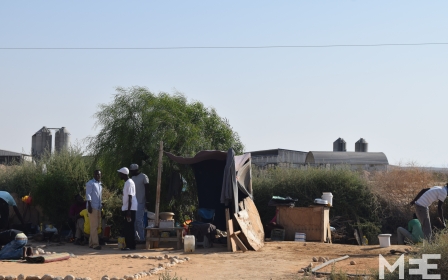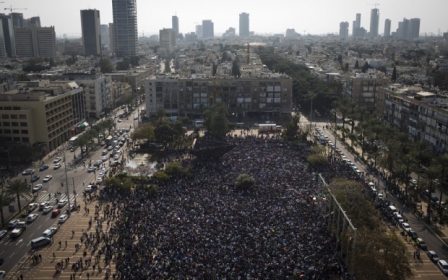Tel Aviv: A city of pleasure and despair

TEL AVIV - Abraham, 25, is looking for work. He doesn't mind if it's a role involving manual labour of some kind, but he needs something, and soon. He left his country of Eritrea at the age of 21 and hoped to find a better life in Israel, or at least a job.
Almost four years later, Abraham still finds himself among hundreds of other African men, hanging around Levinsky Park from as early as 5am, looking for someone to pick him up for an illegal cleaning or construction job. Like all the others waiting here, he doesn’t have a work permit.
“Israelis know they can find cheap workers here. They only pay us 25 shekel [about $6] an hour, while the work is usually heavy. But my rent is 2,500 shekel, so what am I supposed to do?”
The park is located in Neve Sha’anan, in South Tel Aviv, nearby the infamous Central Bus Station. This is where refugees are sent when they are released from Holot Detention Centre in the Negev desert. Most of the refugees stay in that neighbourhood and, like Abraham, live in overcrowded and poorly maintained apartments. The 50,000 refugees who have entered Israel by illegally crossing the Egyptian-Israeli border mostly come from Sudan and Eritrea.
Israel refuses to give them residence permits, but international law prohibits the country from deporting them back to their countries of origin. Right-wing residents have demonstrated more than once against the presence of these "infiltrators" - their term for the African refugees. Miri Regev, the current minister of culture, once compared them to cancer.
'They want the Africans out of here'
David Elkayam, 54, owns a supermarket next to Levinsky Park, opposite to a meat shop called the Kingdom of Pork. He has seen the neighbourhood change in the past 20 years, and he doesn’t mind at all.
“The large majority of my customers are from Sudan or Eritrea. 99 percent of them are very friendly people and they work hard. I have four employees and one of them is African. Actually, I see him more as my business partner.” Elkayam admits however, that not every Israeli feels as positive about the refugees. “It’s about colour. They want them out of here, just because they’re black.”
When an employee of a pet shop around the corner was asked his opinion about South Tel Aviv, he shook his head. “What do you mean? The Africans? I’m not going to talk about them. I don’t need a stone through my window.” He walks back to the counter and takes a sip of his beer.
In his shop in Salamon Street, next to some little supermarkets owned by Africans, 65-year-old Jack is playing backgammon. He mainly sells CDs of forgotten Israeli singers and porn DVDs. Jack owns four apartments in the neighbourhood, which he rents to refugees. However, he said he prefers Israeli clients.
“The Africans are dirty. When you see them walking down the street, they are all dressed up. But their houses are extremely filthy. And they steal. They even had their own market dealing in stolen goods for a while.”
Good vibes and freedom
Established a century ago, Tel Aviv is a relatively young city. It doesn’t have a historical centre or ancient monuments, but nevertheless is advertised as a great attraction for people from other parts of the country – and the world. About 2.3 million tourists visit the city every year, and not only because of the climate and the beaches.
“What is special about Tel Aviv are the people, they are the real monument,” a spokesperson of the municipality says. “Tel Aviv is a city that is open, alive and kicking 24/7. We have 1,748 cafes, nightclubs and places of entertainment - which is one for every 230 residents.”
This is Eyal’s Tel Aviv. The city centre with its entertainment area and resplendent Rothschild Boulevard is a completely different world from the impoverished south, but only a 10 minutes’ walk away. “There are so many things to do here, so much to experience. Tel Aviv has a good vibe, you have the freedom to explore the real you,” says Eyal, who would like to stay anonymous because he’s not completely out of the closet yet. He is a typically young and bronzed Tel Avivi who enjoys going to the beach and to the many gay parties the city is famous for. Eyal says he would only go to the "bad" part of the city when the famous club The Block, that’s situated in the south, organises a gay night.
According to the 29-year old, most of the African immigrants didn’t flee their home country from violence and despair. “When those people come to a developed country, they simply want to improve their lives. And in order to get a residence permit, they just claim to be refugees. It’s like what is happening in Europe right now.”
Still, Eyal considers the drug issues in the neighbourhood to be just as serious. “I wouldn’t walk around in every neighbourhood in the south alone at night. That’s not only because of the Africans, but also because of the junkies.”
'Shaking hands with death'
Sitting on her broken office chair next to her tent and with a cigarette in her hand, Nana is trying not to fall asleep. The ground is covered with garbage: plastic bags and bottles, needles, a shoe, cigarette butts, clothes, a steering wheel, razor blades and used condoms. The smell of urine is overwhelming. This camp is close to Levinsky Park, situated against the background of the shiny skyscrapers of Tel Aviv.
According to Nana, about 40 Israelis live here, all from Russian descent. And they’re all addicted to heroin or other intravenous drugs. She raises her head. “How much money can you give me? I need something to fill my pockets. Everything is so expensive here.”
Nana’s parents moved from Russia to Israel in the 70s when she was a teenager. She’s reluctant to speak about what happened to her and her family after they arrived, but she admits she has been addicted for decades. “I take as many shots as possible, depending on how much money I have. A shot of heroine costs 50 shekels. I would take a hundred shots a day if I could afford it.”
Although the African refugees and homeless drug addicts reside in the city’s "backyard" or "backstage," as it is often called, this doesn’t mean that this part of the city stays completely hidden from Tel Aviv’s residents and tourists. The Africans often have small jobs in restaurants in the city centre or in the hotels near the beach.
According to the Tel Aviv municipality, the issue of the African refugees has had their attention for many years.
“The municipality has invested billions of dollars in the complete makeover of the infrastructure, welfare, security, education etc in the southern neighbourhoods,” a spokesperson says. “In the last years, the municipality has lobbied the government to demand a formal governmental immigration policy, but with no results to date.”
Although when it comes to the homeless drug addicts, the municipality doesn’t seem to be very involved. “This is a phenomenon that is very common in global cities. You will find it in other places as well,” the spokesperson states. The question of the municipality's policies towards the issue of homeless addicts remains unanswered.
“Come on, give me a hand, it’s getting too hot.” Nana is trying to move into the shade, but she has difficulty walking. Her legs are swollen. When she tries to get up, her jeans fall down a little. She has wet herself.
“And can you bring me my chair? I need...” Every now and then, Nana’s coughing forces her to stop talking. “The problem is that I've fucked up my lungs. But it doesn’t really matter anymore, I'm already shaking hands with death.”
Middle East Eye propose une couverture et une analyse indépendantes et incomparables du Moyen-Orient, de l’Afrique du Nord et d’autres régions du monde. Pour en savoir plus sur la reprise de ce contenu et les frais qui s’appliquent, veuillez remplir ce formulaire [en anglais]. Pour en savoir plus sur MEE, cliquez ici [en anglais].






